Posted by: Ken @ 1:47 pm
In a random but unknowing act of kindness, the construction worker tossed his half-eaten sandwich on a snowbank along the road, and returned to his job. A small flock of dark-feathered birds flew down and shared the treat…
But, wait. I’m getting ahead of this story. I might have started with “It was a dark and snowy morning when we drove to the top of the world…” Instead, let’s begin by recollecting our repeated futile attempts to find rosy-finches on the top of Sandia Crest, 10,678 feet above sea level, near our previous home in New Mexico. Several times since moving there in 1993, Mary Lou and I would follow up on reports of rosy-finch sightings on or near the Crest, only to be disappointed.
“It was a clear and cold morning…” in early December, 1999 when we finally plugged three gaping holes in our life lists. We rejoiced while we watched about twenty birds, including all three rosy-finch species, as they devoured the aforementioned bread crusts at the site of the radio/TV transmission towers just across the parking lot from the Crest House Restaurant and Gift Shop.
The next morning we repeated the 13 mile drive up the Crest Road, carrying a supply of wild bird seed. Halfway up, snow started falling and we drove slowly to the top. We scattered seed generously on the snowbank where we had first seen the finches. They did not disappoint us, as within minutes a dozen or more appeared along with some juncos and they swarmed over the seed.
Upon revisiting a few days later we found that a snowplow had distributed the seed all along the roadway, burying some, and exposing the birds to a traffic hazard. This time we spread some seed on a windswept snow-free area on the upper parking lot. Every week until the end of February, 2000 we continued bringing seed, and birders started noticing the rosy-finches. The next winter we resumed our surreptitious feeding, and found that others were also scattering seed, not only on the parking lot surface, but also on ecologically fragile areas along the observation area at the top of Sandia Crest. We publicized our concerns on the Internet, and this resulted in our receiving dozens of inquiries about the rosy-finches. To manage the requests for information, we set up the rosyfinch.com website.
As Forest Service volunteers, we knew full well that wildlife feeding violated the agency’s policies, so we approached our friend Tom Duncan, who was then the resident manager of Sandia Crest House. He talked to Forest Service people and learned that the prohibition against feeding applied only to “undisturbed” land; the Forest Service interpreted any private leases or concessions within the National Forest boundaries to be “disturbed” land, thus exempting the Crest House.
Tom erected a feeder only about three feet outside the main entrance to the Gift Shop, and it immediately attracted rosy-finches. The trouble was that they were frightened away every time someone entered or exited, and they could not be observed from inside the building.
We engaged Central New Mexico Audubon, the US Forest Service, Crest House management as well as a local bird seed supplier in an agreement whereby three feeders were installed, to be maintained by Forest Service volunteers. Spurred on by enthusiastic younger birders, most notably the late Ryan Beaulieu and his friend, Raymond VanBuskirk, Rio Grande Bird Research, Inc., managed by Steve and Nancy Cox, expanded its operations to include weekly rosy-finch banding sessions at the Crest House during the winter months. Read more about Ryan’s untimely death and how Raymond helped carry on his legacy at the link to the June 2010 issue of Audubon Magazine on this page.
After Gene Romero took over as manager of Crest House, the facility was renovated to include an improved dining area with large picture windows that provide a clear view of the deck feeder. Gene and his staff have become avid watchers and protectors of the rosy-finches and, during the warm months, myriad hummingbirds that frequent their feeders. Local merchants donated feeders and seed, and Mary Lou and I coordinated the feeding program, driving up about twice a week to tend them. We moved away from New Mexico to Florida in 2004, and now Dave Weaver and his spouse Fran Lusso carry on as co-coordinators of the feeding project. For more information about the rosy-finches at Sandia Crest, see my Birder’s World article.
Since banding began in March, 2004 through the end of last winter, the team had accumulated a total of over 2200 newly banded rosy-finches. The species mix of newly banded birds is interesting. So far, 54% have been Black Rosy-Finches. The Brown-capped species made up approximately 28%, and Gray-crowned Rosy-Finches accounted for 18%. A little over half of the 432 Gray-crowned Rosy-Finches banded were Hepburn’s race, but of these 159 birds, most (133) were banded during the two winters of 2006-07 and 2007-08. Detailed results of banding are available here
Although we now have homes in Florida and Illinois, I remain a New Mexican at heart. Mary Lou? Well, she certainly enjoyed most of our eleven years of living at 7000 feet in the mountains of New Mexico, but not the winters. As she says, she was born in December and hasn’t thawed out yet! However, we had not seen our five Texas grandchildren since our 50th wedding anniversary reunion in the Colorado Rockies, over a year ago. We planned to fly to Amarillo for a “grandchildren fix” this fall, but it took a bit of effort on my part to convince her that we should fly home out of Albuquerque rather than Amarillo. After all, the cheaper return air fare would offset the incremental cost of a one-way car rental from Amarillo to Albuquerque. I also made sure that the trip occurred after the arrival of the rosy-finches to Sandia Crest. The first ones usually appear around the first of November, but this year they came in late. By November 9, no more than 6 Rosies had been seen at the feeder.
We had a very nice visit with our son, his wife and their five children, in Amarillo, Texas. On November 12, we drove west on I-40 to New Mexico. As we approached Albuquerque, we could see the snow-capped mountains of Santa Fe and Taos to the north, a promising sign, as snow cover tends to concentrate the rosy-finches at the feeder. We arrived at Sandia Crest around noon. It was a cold 29 degrees Farenheit, with a brisk southerly wind with gusts to 50 miles per hour.
This is the view to the south from the deck of Crest House.
There had been a dusting of snow the previous day, but the deck of the Crest House was clear. The feeder hangs over the far end of the railing; a hungry Abert’s Squirrel can be seen running along the top of the rail towards it (click on photo to select larger views).
We saw a total of six Rosy-finches on November 12. Among them, we identified three Black Rosy-Finches and one that looked like a Gray-crowned. This is a Black Rosy-Finch.
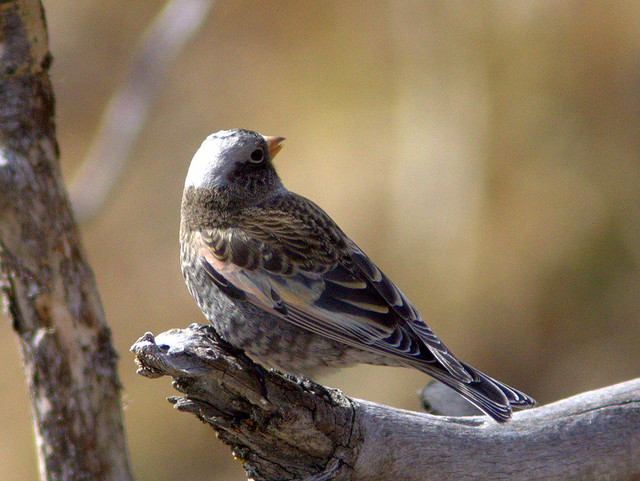
This bird that we first thought to be a Gray-crown was more brownish, but close examination of the photo reveals it to be an adult female Black Rosy-Finch. The angle of light caused reflection that made the bird look lighter than it really was.
An Abert’s Squirrel was dominating the feeder, and we had to chase it away repeatedly. The Rosies avoided the feeder when either the squirrel or a Steller’s Jay was present.
Mountain Chickadees shared the feeder…
…with Red-breasted Nuthatches…
…and the local Gray-headed race of the Dark-eyed Junco.
The next day, the forecast called for snow, but we ventured up Crest Road again. It started to rain as we checked for Pygmy Nuthatches at Doc Long Picnic Area near the base, and clouds enveloped the mountain. We turned back, deciding to bird around Albuquerque. We returned to the Crest on November 14, negotiating snow-packed areas on the road. Near the top, the moisture from the clouds had condensed to form a thick layer of hoarfrost on the trees.
Now there were flocks of up to 13 Black Rosy-Finches at the feeder. Here, two are perched on a frosty branch.
Before the banders introduced a degree of sophistication into our identification of the rosy-finches, we gave up on identifying many of the hatch-year birds, especially early in the season, as all have buffy brown tips on their contour feathers. At first we simply called them “Rosy-Finch sp.,” or “Buffies.” Now we know to take a closer look at the bases of the feathers. If they are black or very dark brown, and the bird has a whitish crown, it is a Black Rosy-Finch. Immature Gray-crowned Rosy-Finches have more cinnamon-brown feather bases. Male Blacks, even immature ones, show rather extensive pink on their underparts and wing coverts, while in females the color is very subdued. Even adult Gray-crowned Rosy-Finches show relatively little pink. This indeed is an immature (hatch year) female Black Rosy-Finch. Note the hint of pink on her shoulders and lower belly.
Our disappointment at not being able to positively identify any Gray-crowned Rosy-Finches was tempered by the appearance of the first Brown-capped Rosy-Finch of the season. Note its lack of a light crown and the more intense rosy undersides. A band from a previous season confirms that it is an adult.
Although the temperature had dropped to 22 degrees, the winds had died down, and photography conditions were much better than two days previously. Somehow, this beautiful adult black-Rosy-Finch had escaped the banding traps in previous years.
Though my fingers were about to freeze and drop off, I was able to get a nice shot of a Mountain Chickadee against a natural background…
..and a Red-breasted Nuthatch in a typical pose.
I shot this photo of a Steller’s Jay from inside the windows of the Crest House. Staff had spread the seed around to allow the finches to visit without being harassed by the jays.
Sandia Crest, just east of Albuquerque, New Mexico, is the most accessible site in the world where all three North American rosy-finch species can be seen at one time. We maintain the Sandia Crest Birding FORUM, where you will find interesting discussions on identification as well as updated sighting reports of not only the Rosies, but also such more unusual birds as Clark’s Nutcracker, Red Crossbill, Cassin’s Finch, Northern Pygmy-Owl and American Three-toed Woodpecker.







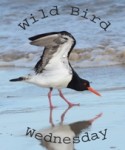






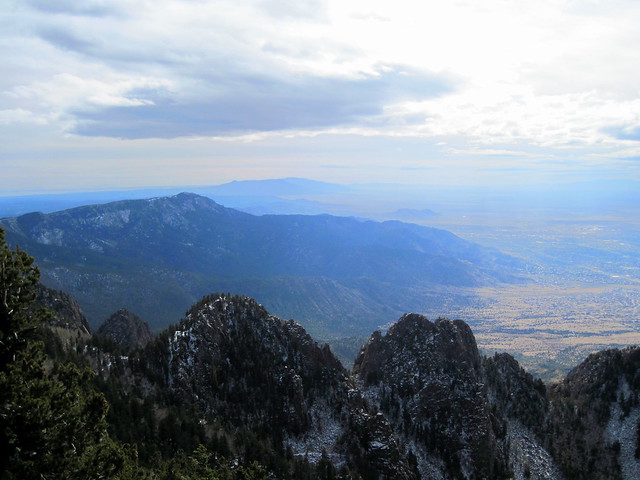

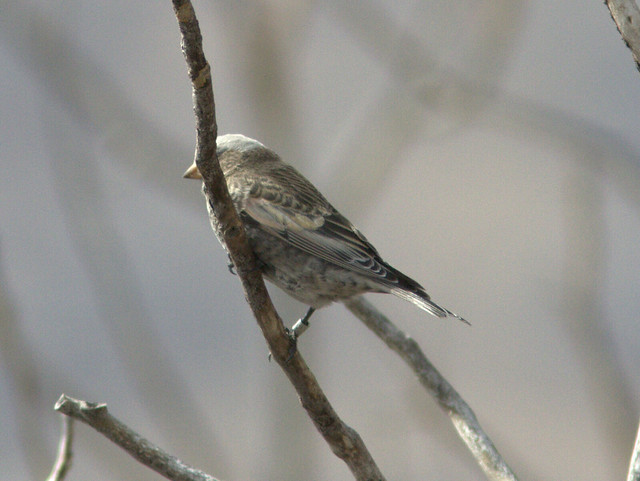
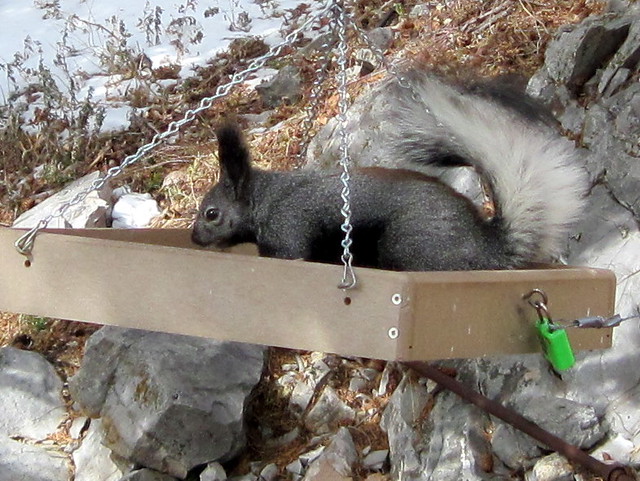











November 20th, 2011 at 6:45 pm Great post and I love all the birds especially the Rosies!!
November 22nd, 2011 at 4:10 pm Beautiful, close up shots, Ken! I’ve never seen an Albert’s squirrel…quite different from the Gray and Fox squirrels I’m used to.
November 22nd, 2011 at 4:22 pm A wonderful post to read…. winter is very close over here.. I have to admit I don’t really enjoy it.
November 22nd, 2011 at 4:31 pm A very interesting post (again!) and beautiful birds and scenery. Your post reminds me that this is truly a meme for world birds! December is such a hot month out here!!
November 22nd, 2011 at 6:53 pm A beautiful post. Love all the beautiful birds, most of them I’ve never seen.
November 22nd, 2011 at 8:28 pm I need all 3 of these species for my life list. If I ever get back that way I will have to visit here! Outstanding photos and information! Thank you!
November 23rd, 2011 at 12:34 am What a great post Ken, with excellent pictures too. I love that Nuthatch, in the typical pose.
November 23rd, 2011 at 12:24 pm Really interesting and well-written post! Beautiful scenery and stellar (not just the Jay) photos of birds. I like the little squirrel too!
November 23rd, 2011 at 2:36 pm Great post!! Boom & Gary of the Vermilon River, Canada.
November 23rd, 2011 at 5:28 pm Amazing post Ken, loved every word of it. I guess you can go home again! You lived there how many years? You must miss that view. Great pictures of your beloved finches. I especially liked the hoar frost photo of the Blacks. Winter seems pretty in that photo. Thanks for sharing your experience, I’ll bet the Grandkids were happy!
November 24th, 2011 at 12:16 am Hi Ken, I wanted to let you know that I nominated you for the Liebster Blog Award. You can read all about it on my website: judysjottings.wordpress.com.
November 27th, 2011 at 6:37 pm @BJK– Thanks for your comments, BJK– Yes, with their black bodies and white on their tails they almost look like skunks when they run across the ground. Some have ear tufts so big that they look like rabbits. @Kathie– plan to get out to Sandia Crest at any season. Of course, November-March is best for the Rosies! @ Andrew & Mick– I like four seasons. Florida has only two– Hot and wet, and warm and dry. I must admit the winters are great here. This week we just opened our windows at night for the first time. @Springman– we “retired” to the mountains of NM in 1993 and lived there 11 years, moving to Florida in 2004, expecting to be very near our younger daughter and two of our little granddaughters, but her husband got promoted and they moved to Chicago before we had time to settle in. Now we live up in NE Illinois for most of the warm months. @ Judy– Thank you so much for the honor. I so enjoy reading your blog, as it brings me back to my beloved virtual home in the Land of Enchantment!
February 7th, 2012 at 10:05 pm Hah! That is a smart squirrel to ferret out the feeder so quickly. I hope you enjoy our state and our hungry squirrels. Cute site you have here!